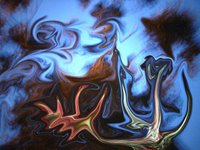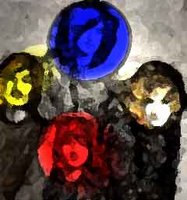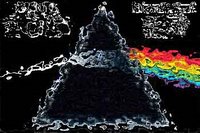
Vinny Bhagat—laptop/percussion/field recordings
Kym Gluyas – Saxophone/electronics
Chris Martin – Electric piano
Maria Fava - Video camera and Projections

Collaborations with other Artists:
Tyrell Blackburn : Laptop
Derek Pasco - Saxophone
Jay Dabgar - Tabla
Josh Benett : Sitar,guitar
Ashhar Farooqui : Voice and Fx
Tom Buchanan : Live Art
W.T Masseli - Art display
Maura Oregan : choreography
Lea Czikowski : choreography
Luke Toop – visual projections and video camera

Our performance is like a journey, which can start with ambient minimal found sounds and climbs to various areas of abstract sonic art and electronica. The music is created through code, artificially synthesized sound, rhythm’s and field recordings, all of which are processed in real time and accompanied by more human players on various acoustic instruments , video camera , objects and tools, that often puts the listener into an unfamilair "interesting-spatial" environment. The spontaneous nature of the music means you hear a one off performance.
History and Gigs:
 Meeting at The Elder Conservatorium Of Music, University Of Adelaide we started an improvised computer music project in April 2005 that began with our first live performance on South Australian Composers Symposium - Radio Adelaide.Thanks to presenter Alex Carpenter for his offering.
Meeting at The Elder Conservatorium Of Music, University Of Adelaide we started an improvised computer music project in April 2005 that began with our first live performance on South Australian Composers Symposium - Radio Adelaide.Thanks to presenter Alex Carpenter for his offering.Originally only putting the group together for this performance, we found our selves being offered a show for the opening of The Delicatessen Gallery @ 2005 and then a slot on the bi monthly COMA performance’s (Creative Original Music Adelaide) by the listeners for the Hipnote Autumn Sessions 2005. Since then the group has evolved into various streams of experimental music, computer music and visual Art and now its led by Vinny Bhagat often inviting other artists from diverse backgrounds from Adelaide, interstate and overseas to perform in the concerts. Distributed performances is an highly interesting concept, breaking all the barriers of distance, performers in one physical place and traditional musical practises. Still a long way to go, but definately this is/will be/can be the new way of performances.
Shivna Kaun Quartet
*noise
*nature
*hammers
*landslides

“Whereas, in the past, the point of disagreement has been between dissonance and consonance, it will be in the immediate future, between noise and so called musical sounds”(John Cage 1966)
Noise is often thought of as the opposite of music, something that is undesirable and ugly. Music of different cultures have made a clear distinction between musical sounds and noise. To Helmholtz musical sound was “…. a perfectly undisturbed, uniform sound which remains unaltered as long as it exists” (Helmholtz 1954). The term ‘noise’ is itself a description of a timbre. In comparison, musical tones are ‘regular and uniform’ whereas noises are ‘confused and irregular’. Splashing of water, whistling of the wind, a boiling kettle or a passing truck are all examples of musical noises. “Noises are useful to new music as so called musical sounds for the simple reason that they are sounds”(Walker 1970).
“However if the word “music” is sacred and reserved for eighteenth and nineteenth century instruments, we can substitute a more meaningful term: organization of sound” (John Cage 1966)
“Music Concrete, one of the early forms of electronic music grew out of the fascination with the musical possibilities of environmental noise”. (Abraham 1960). Percussion music on the other hand is influenced from a similar idea where the point of reference is the underlying rhythm, to the extent that any sound is acceptable to the composer.
Electronic music is only limited by the relationship that exists between the human ear, the mind and the acoustic sound. However “it is clear that the composer of electronic music should not attempt to imitate timbres of traditional instruments”(Stockhausen 1962), it becomes a necessity for the audience not to accept any familiar patterns and sounds their ears are use to.
Shivna Kaun looks to stretch the scope of deep listening and sonic meditations to a larger audience.
 2005 Gig Guide
2005 Gig Guide* South Australian Composers Symposium - Radio Adelaide, 11am, 21 April 2005
* Opening of the Delicatessen Gallery, July 2005
*COMA (Creative Original Music Adelaide) 15 Aug'05 –Wheatsheaf 8PM
2006 Gig Guide:
* Fringe 06- Fresh Bait , 27 Feb & 6 March, Fowlers live 68 North Terrace
* Tyndall Assembly – 16 March , Delicatessen Gallery 7PM
* Lizard Lounge ,Hindley Street 19 March 8PM
* Local Noise 9 May Radio Adelaide 101.5 FM 9 Pm
* ACMC'06 and Ear Poke at Jade Monkey 12 July'06 -- 8pm onwards
* Adelade University - Uni Bar 28 July'06 6Pm
* SALA Exhibition 7 August’o6 (opening night)
* COMA (Creative Original Music Adelaide) 21 Aug 06 –Wheatsheaf 8PM
2007 Gig guide
* Allans Music Store -- Adelaide : 19 January, 5pm
* "Hope for Genreation" Producers bar -- 1 July, 11pm
* "Tyndall Assembly", Gallery De la catseen -- 26 July ,8pm
* Visa expiration Party -- COMA, Wheatsheaf -- 10 September, 8pm
* Exeter - experimental wednesdays
2008 gig guide
* Exeter - experimental wednesdays..2 jan
* Coma, Hipnote Summer series @ Wheatsheaf Hotel, Adelaide - 7th Jan
* NowNow Festival.."Festival Club".. Blue Mountains..NSW.. 18,19Jan..
* Dela catseen Gallery, Adelaide. 7th Feb'2008 .. 7pm
* Togetherness Show.Adelaide.. Rymel Park. 17 Feb 2008.. late avo..
=======
WORKS
=======
* Excerpt : Video Feedback, 2007
( Music by Vinny Bhagat and Video by Maria Fava )
Tracks: ( All tracks written and composed by Vinny Bhagat)
* Chattswood ( 2008 )
* Sonic Textures (2007)
* Timbre Tree (2007)
* super_network work(2007)
* Mosque in war times (2007)
* Birth Chart (2006 )
Concert excerpts:
* HipNote Winter Sessions @ Wheatsheaf,Adelaide 7.1.2008
Excerpt 1 Excerpt 2 Excerpt 3 Excerpt 4 Excerpt 5
* Angry Jam,2006
* Allans Music, Adelaide, Jan 2006
* Fowlers Live, Adelaide Fringe 2006
* Kym's place,2005
Sound Design Works
* What is Music ( 2007 ) Film By Daniel Murtagh
* Worms ( 2007 ) Animation by Tim Forbes and Christina Erdos
* Emergence Games Sound Logo (2006)
* L'vertie Incroyable. Film by Tamas Major ( 2006)
* Bushanza..Animation by Ronald Keller..( 2005)
Tribute
* Om Jai ( Indian Prayer for the Gods )
* Hot Rodes : to hand playing
Video Exploration
* Incident of Video Feedback ( Music Work in Progress )











